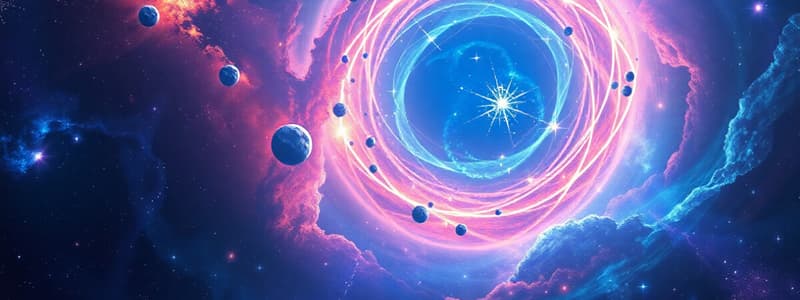Podcast
Questions and Answers
What is the primary driver of plate tectonics?
What is the primary driver of plate tectonics?
- Wind patterns in the atmosphere
- Gravitational pull from the moon
- Solar radiation
- Earth's internal heat (correct)
Which gas makes up the largest percentage of the Earth's atmosphere?
Which gas makes up the largest percentage of the Earth's atmosphere?
- Oxygen
- Nitrogen (correct)
- Argon
- Carbon dioxide
What percentage of Earth's water is classified as fresh water?
What percentage of Earth's water is classified as fresh water?
- 15%
- 1%
- 5%
- 3% (correct)
During photosynthesis, what is sequestered from the atmosphere?
During photosynthesis, what is sequestered from the atmosphere?
What is the biosphere primarily characterized by?
What is the biosphere primarily characterized by?
What does the coma of a comet primarily consist of?
What does the coma of a comet primarily consist of?
What causes the ion tail of a comet to form?
What causes the ion tail of a comet to form?
How often is Halley's comet visible from Earth?
How often is Halley's comet visible from Earth?
What is a meteorite?
What is a meteorite?
Where are most asteroids located in the solar system?
Where are most asteroids located in the solar system?
What is the main component of the Earth's atmosphere?
What is the main component of the Earth's atmosphere?
What describes the shape of the Earth?
What describes the shape of the Earth?
Which of the following best describes primitive meteorites?
Which of the following best describes primitive meteorites?
What is the main purpose of the Hertzsprung-Russell diagram?
What is the main purpose of the Hertzsprung-Russell diagram?
Which type of galaxy is characterized by stars arranged in a spherical or elliptical shape?
Which type of galaxy is characterized by stars arranged in a spherical or elliptical shape?
Which of the following best describes a Barred Spiral Galaxy?
Which of the following best describes a Barred Spiral Galaxy?
What characterizes Circumpolar Constellations?
What characterizes Circumpolar Constellations?
Which of the following constellations can be seen in winter?
Which of the following constellations can be seen in winter?
What is a defining feature of Irregular Galaxies?
What is a defining feature of Irregular Galaxies?
Which stars are commonly found within the five northern circumpolar constellations visible year-round?
Which stars are commonly found within the five northern circumpolar constellations visible year-round?
Seasonal Constellations are best observed at what time?
Seasonal Constellations are best observed at what time?
What event is known to have initiated the expansion of the universe?
What event is known to have initiated the expansion of the universe?
Who first proposed the idea that the universe started as a single point?
Who first proposed the idea that the universe started as a single point?
What happens to the color of a galaxy as it moves away from an observer?
What happens to the color of a galaxy as it moves away from an observer?
What is a key component of a star's composition?
What is a key component of a star's composition?
What type of diagram is essential for studying stars?
What type of diagram is essential for studying stars?
What does redshift indicate about a galaxy's movement?
What does redshift indicate about a galaxy's movement?
What is the significance of microwave background radiation in relation to the universe?
What is the significance of microwave background radiation in relation to the universe?
What occurs when stars die in the universe?
What occurs when stars die in the universe?
What does Kepler's Law of Equal Areas indicate about a planet's speed in its orbit?
What does Kepler's Law of Equal Areas indicate about a planet's speed in its orbit?
Which of the following statements best describes Kepler's Law of Harmonies?
Which of the following statements best describes Kepler's Law of Harmonies?
What aspect of Pluto and Charon's characteristics is true?
What aspect of Pluto and Charon's characteristics is true?
Which statement accurately reflects Newton's Law of Interaction?
Which statement accurately reflects Newton's Law of Interaction?
What characteristic defines comets in our solar system?
What characteristic defines comets in our solar system?
Which of Newton's Laws states that an object remains at rest unless acted on by an external force?
Which of Newton's Laws states that an object remains at rest unless acted on by an external force?
According to Kepler's Law of Ellipses, how is the sun positioned in a planet's orbit?
According to Kepler's Law of Ellipses, how is the sun positioned in a planet's orbit?
What does Newton's Law of Universal Gravitation state?
What does Newton's Law of Universal Gravitation state?
Study Notes
The Universe
- The universe contains everything that exists, including matter and space.
- It is at least 10 billion lightyears in diameter
- The universe is expanding.
- The Big Bang theory states that the universe started as a single point about 13 billion years ago.
The Big Bang Theory
- George Lemaitre proposed the Big Bang theory in 1927.
Evidence of The Big Bang Theory
Red Shifting
- Redshift happens when galaxies move away from the observer.
- This is caused by the stretching of light waves as the object moves away.
- Blue-shifting occurs when objects move towards observers.
Microwave Background
- As the universe expanded, it cooled down, leaving behind a glow.
- This glow is visible as microwaves, which are a part of the electromagnetic spectrum.
Stars
- Stars are massive celestial objects that are made up mostly of hydrogen and helium.
- Stars are the building blocks of galaxies.
Classification of Stars
- The Hertzsprung-Russell diagram plots the luminosity of stars against their temperature.
Galaxy
- A galaxy is a group of stars and galaxies held together by gravity.
- There is space between galaxies and stars.
Classification of Galaxies
Elliptical Galaxy
- Stars are arranged in a spherical or elliptical shape.
- They do not have extended curved arms.
Normal Spiral Galaxy
- Consists of two or more regions.
- Has a central nucleus where many stars are located.
Barred Spiral Galaxy
- Has two broad, extended bars from which spiral arms curve outward.
Irregular Galaxy
- Has no specific shape.
Constellation
- A constellation is a group of stars that forms a pattern in the sky.
- Constellations are used for navigation and telling time.
- There are 88 total constellations.
Types of Constellations
Circumpolar Constellation
- Circumpolar constellations are visible from most locations north of the equator throughout the year.
- Examples include Cassiopeia, Cepheus, Draco, Ursa major, and Ursa minor.
Seasonal Constellations
- Seasonal constellations only appear in the sky during certain times of the year.
Planetary Motions
- Johannes Kepler developed three laws of planetary motion based on Tycho Brahe's observations.
Law of Ellipses
- The orbits of planets are ellipses with the sun at one focus.
Law of Equal Areas
- Planets move faster when they are closer to the sun and slower when they are farther away.
Law of Harmonies
- The square of a planet's orbital period is proportional to the cube of its average distance from the sun.
Newton’s Law of Motion
- Isaac Newton developed three laws of motion.
Law of Inertia
- An object in motion will stay in motion and an object at rest will stay at rest unless acted upon by an external force.
Law of Interaction
- For every action, there is an equal and opposite reaction.
Law of Universal Gravitation
- Every object in the universe is attracted to every other object with a force that is directly proportional to the product of their masses and inversely proportional to the square of the distance between their centers.
Other Celestial Objects in our Solar System
Comets
- Comets are icy bodies that orbit the Sun.
- They contain frozen gases, rock, and dust.
- When they get close to the sun, they heat up and release dust and gases.
- Components: nucleus, coma, dust tail, and ion tail.
Meteors
- Also known as shooting stars.
- They are pieces of meteoroids that fall from space that enter the atmosphere and create a flash of light.
Meteorites
- Pieces of a meteor that survive their descent through the atmosphere.
- They have dark and rough crusts due to burning through the atmosphere.
- Primitive meteorites are essentially unchanged since the solar system's formation.
Asteroids
- Asteroids are small, rocky objects that orbit the sun.
- Most of them are found in the asteroid belt between Mars and Jupiter.
The Earth
- The Earth is the third planet from the sun.
- It is a solid, spherical, rocky body with oceans and an atmosphere.
Composition of the Earth
- 21% of the earth's atmosphere is oxygen.
- Over 90% of the Earth's crust is oxygen.
The Earth's Shape
- The Earth is an oblate spheroid, meaning its poles are flattened.
Earth System
- The Earth system is a closed system that receives energy from the Sun and also returns energy to space.
Atmosphere
- Composed of: 78% nitrogen, 21% oxygen, 0.9% argon, and trace amounts of other gases.
Lithosphere
- Includes the rocks of the crust and mantle, the metallic liquid outer core, and the solid metallic inner core.
Plate Tectonics
- The Earth's internal heat drives plate tectonic movement.
Hydrosphere
- About 70% of the Earth is covered by water, most of which is in the form of ocean water.
- 3% of the Earth's water is freshwater. Two-thirds of this is in the form of ice, and the other one-third is in streams, lakes, and groundwater.
- Oceans are important sinks for CO2 and play a role in heat absorption and redistribution.
Biosphere
- The biosphere is the set of all life forms on Earth.
- It encompasses all ecosystems.
- Photosynthetic organisms form the base of the food chain.
- The biosphere is a CO2 sink and an important part of the carbon cycle.
Studying That Suits You
Use AI to generate personalized quizzes and flashcards to suit your learning preferences.
Related Documents
Description
Explore the vastness of the universe and the Big Bang theory through this quiz. Learn about redshifts, microwave background radiation, and the classification of stars. Test your knowledge on the building blocks of galaxies and the expansion of the cosmos.




